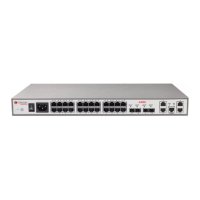A10E/A28E/A28F Configuration Guide
CoS priority locates at the first 3 bits of TCI field, value range is 0–7, as shown below. It is
available to guarantee service quality in Layer 2 network.
Figure 4-5 Structure of CoS priority packets
4.1.4 Traffic policy
Perform different operation for different packets after classifying packets flow, the traffic
classification and operation binding form the traffic policy.
Rate limiting
Rate limiting is to control network flow, by monitoring flow rate enters network to discard
overflow part and control the entering flow in a reasonable range, thus to protect network
resource and carrier interest.
The A10E/A28E supports rate limiting based on traffic policy in the ingress direction on the
interface.
The device supports to use token bucket for rate limiting, including single-token bucket and
dual-token bucket.
Re-direction
Re-direction means to forward packets in the original corresponding relation between
destination and interface, it forwards packet to assigned interface to implement policy routing.
The A10E/A28E supports redirect packets to the specified interface for forwarding in
interface ingress direction.
Re-mark
Re-mark means to set some priority fields in packet again and then classify packets according
to self-defined standard. Besides, downstream node in network can provide diverse QoS
service according to re-marked information.
The device supports re-mark for below priority fields:
IP packets IP priority
DSCP priority
CoS priority
Traffic statistics
Traffic statistics is used for data packets statistics of specified service flow, which is the
number of packets and bytes passed through matching traffic classification or discarded.
Traffic statistics is not QoS control measure, but can be used in combination with other QoS
actions to improve network supervision.

